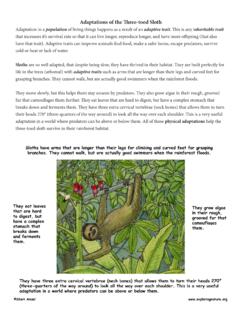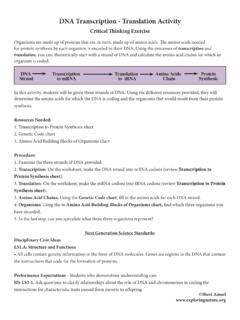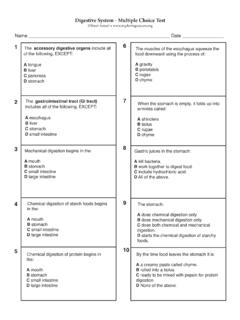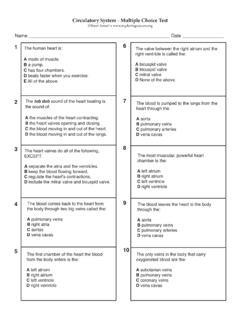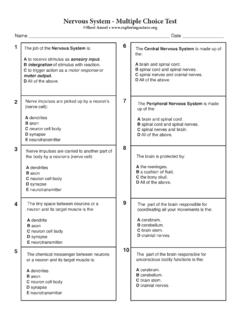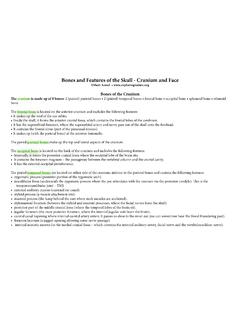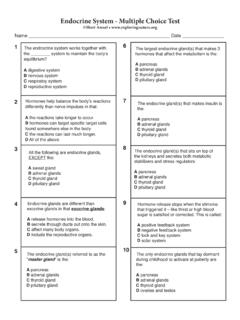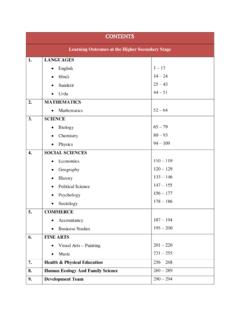Transcription of Matter Assessment and NGSS - Exploring Nature
1 Phases of Matter Multiple Choice QuizName: _____ Date: _____ Class: _____12345678 All of the following are phases (states) of Matter EXCEPT:A solidB liquidC gasD puttyThis Matter has a fixed shape and volume with particles closely packed together with little movement. It is a:A liquidB solidC gasD plasmaWater is different from other substances because:A It is more dense as a solid than a liquidB It is less dense as a solid than liquidC it is more dense as a gas than a liquidD It is less dense as a solid than a gasWhich of the following substances has a higher melting point than water?A saltB sugarC flourD all of the aboveWhich of the following is NOT a way that Matter changes phase?A meltingB freezingC evaporationD mixingMatter changing from a solid to a gas is called:A evaporationB sublimationC depositionD meltingThe melting point of water is:A 0 CB 100 CC 32 CD 60 C Sheri Amsel changing from a solid to a liquid is called:A evaporationB sublimationC depositionD meltingPhases of Matter - Vocabulary QuizName the six ways the phase (state) of Matter changes:1.
2 _____2. _____3. _____4. _____5. _____6. _____123465 Sheri six ways phases of Matter change. Sheri Amsel or Sublimation Sheri Amsel Important Points about Phases of Matter1) What is Matter ? _____2) Name the three phases (states) of Matter ? _____3) Identify and describe the particle in each phase of Matter and how they are different in each phase of Sheri Amsel KEYS1) What is Matter ? Matter is something that has mass and ) Name the three phases (states) of Matter ? The three most common phases of Matter on Earth are solids, liquids and ) Identify and describe the particle in each phase of Matter and how they are different in each phase of solid s particles are packed closely together.
3 There is not much space between the particles and there is little particle movement. Liquids have a fixed volume, but take the shape of the container in which they sit. There is not much space between the particles, but they can slide past each other and flow easily. Gas fills the shape and volume of the container in which it sits. There is a lot of free space between its particles and they flow easily past each of Matter Multiple Choice KEY1. D2. B3. D4. B5. B6. D7. D8. BPhases of Matter - Vocabulary Quiz1. Freezing2. Melting3. Sublimation4. Deposition5. Condensation6. EvaporationPhases of Matter - Vocabulary Graphic Concepts Quiz 1. Condensation2. Evaporation3. Freezing4. Melting5. Evaporation6.
4 Deposition7. Melting8. Melting or SublimationNGSS and Common Core IntegrationMS-PS1 Matter and its InteractionsDisciplinary Core : Structure and Properties of Matter Substances are made from different types of atoms, which combine with one another in various ways. Atoms form molecules that range in size from two to thousands of atoms. (MS-PS1-1) Each pure substance has characteristic physical and chemical properties (for any bulk quantity under given conditions) that can be used to identify it. (MS-PS1-2),(MS-PS1-3) Gases and liquids are made of molecules or inert atoms that are moving about relative to each other. (MS-PS1-4) In a liquid, the molecules are constantly in contact with others; in a gas, they are widely spaced except when they happen to collide.
5 In a solid, atoms are closely spaced and may vibrate in position but do not change relative locations. (MS-PS1-4) Solids may be formed from molecules, or they may be extended structures with repeating subunits ( , crystals). (MS-PS1-1) The changes of state that occur with variations in temperature or pressure can be described and predicted using these models of Matter . (MS-PS1-4) : Chemical Reactions Substances react chemically in characteristic ways. In a chemical process, the atoms that make up the original substances are regrouped into different molecules, and these new substances have different properties from those of the reactants. (MS-PS1-2),(MS-PS1-3),(MS-PS1-5) The total number of each type of atom is conserved, and thus the mass does not change.
6 (MS-PS1-5) Some chemical reactions release energy, others store energy. (MS-PS1-6) : Definitions of Energy The term heat as used in everyday language refers both to thermal energy (the motion of atoms or molecules within a substance) and the transfer of that thermal energy from one object to another. In science, heat is used only for this second meaning; it refers to the energy transferred due to the temperature difference between two objects. (secondary to MS-PS1-4) The temperature of a system is proportional to the average internal kinetic energy and potential energy per atom or molecule (whichever is the appropriate building block for the system s material). The details of that relationship depend on the type of atom or molecule and the interactions among the atoms in the material.
7 Temperature is not a direct measure of a system s total thermal energy. The total thermal energy (sometimes called the total internal energy) of a system depends jointly on the temperature, the total number of atoms in the system, and the state of the material. (secondary to MS-PS1-4) : Developing Possible Solutions A solution needs to be tested, and then modified on the basis of the test results, in order to improve it. (secondary to MS-PS1-6) : Optimizing the Design Solution Although one design may not perform the best across all tests, identifying the characteristics of the design that performed the best in each test can provide useful information for the redesign process - that is, some of the characteristics may be incorporated into the new design.
8 (secondary to MS-PS1-6) The iterative process of testing the most promising solutions and modifying what is proposed on the basis of the test results leads to greater refinement and ultimately to an optimal solution. (secondary to MS-PS1-6)Crosscutting Concepts:Patterns Macroscopic patterns are related to the Nature of microscopic and atomic-level structure. (MS-PS1-2)Cause and Effect Cause and effect relationships may be used to predict phenomena in natural or designed systems. (MS-PS1-4)Scale, Proportion, and Quantity Time, space, and energy phenomena can be observed at various scales using models to study systems that are too large or too small. (MS-PS1-1)Energy and Matter Matter is conserved because atoms are conserved in physical and chemical processes.
9 (MS-PS1-5) The transfer of energy can be tracked as energy flows through a designed or natural system. (MS-PS1-6)Structure and Function Structures can be designed to serve particular functions by taking into account properties of different materials, and how materials can be shaped and used. (MS-PS1-3)Connections to Engineering,Technology, and Applications of ScienceInterdependence of Science, Engineering, and Technology Engineering advances have led to important discoveries in virtually every field of science, and scientific discoveries have led to the development of entire industries and engineered systems. (MS-PS1-3)Influence of Science, Engineering and Technology on Society and the Natural World The uses of technologies and any limitation on their use are driven by individual or societal needs, desires, and values; by the findings of scientific research; and by differences in such factors as climate, natural resources, and economic conditions.
10 Thus technology use varies from region to region and over time. (MS-PS1-3)Science and Engineering practices : Developing and using ModelsModeling in 6 8 builds on K 5 and progresses to developing, using and revising models to describe, test, and predict more abstract phenomena and design systems. Develop a model to predict and/or describe phenomena. (MS-PS1-1),(MS-PS1-4) Develop a model to describe unobservable mechanisms. (MS-PS1-5)Analyzing and Interpreting DataAnalyzing data in 6 8 builds on K 5 and progresses to extending quantitative analysis to investigations, distinguishing between correlation and causation, and basic statistical techniques of data and error analysis. Analyze and interpret data to determine similarities and differences in findings.

